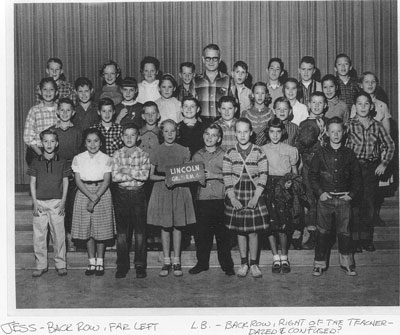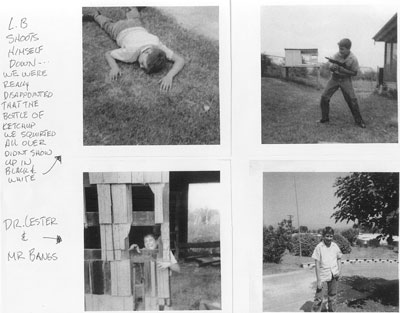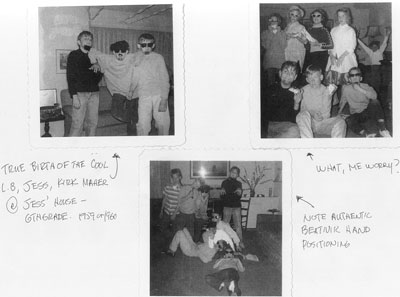Lester in Escondido: A Letter from boyhood pal Jess Montgomery
Dear Jim: I appreciate your response to my email some weeks back. I'm enclosing some photocopied pix I dug up from the good old days in hopes that they'll bring a smile or two. Feel free to share them with anyone who might be interested. Since I wrote to you I've finished the book. It was a pretty sad conclusion, and I think you did a good job of conveying that fact. I've known a number of friends who've met similar fates—clean up their act (substance-wise) only to come to an abrupt demise not long after. Beyond that, though, the creative battle Les waged with himself was something that every successful artist faces (successful artistically as opposed to financially) i.e. how does a creative person deal with the need to become a parody of one's self when, if by doing so, he stops being creative, though usually (for once) he can pay some bills. That's the toughest part of the whole game and not a few have self-destructed. Others become content with the mid-American county-fair circuit and all the corn dogs it can offer. Anyway, that's not what I wanted to talk about. I wanted to write down my remembrance of times with Les, if only because it feels good to think hard about old friends and hopefully share those thoughts with someone who's interested. Nobody I hang with now has ever even heard of the guy. I don't remember exactly, but I'm sure we met in Mr. Kendall's fifth grade class at Lincoln school.
We just hit it off. To me, Escondido wasn't the dark, forboding place that Les recounted, but I had lived there all my life. Like most small towns, it was tough to crack. By sixth grade we already knew who was going to be the homecoming queen and the football star & it wasn't going to be any newcomer, either. I lived about a mile from school in a typical '50s subdivision with about 100 kids within shouting distance. Although I was an only child there was always somebody to carry on with. Les lived in a classic '20s era apartment house—a big old gothic-looking house cut into several apartments, right across the street from the school. I remember hanging out there a lot. His mom usually working—waiting tables, I think, at The Wagon Wheel. She would often bring home pie from work. She was nice—not a raving maniac like some moms, but pretty severe and strict, what I probably recognize now as extremely preoccupied with her & her son's future prospects. Les indeed had his stash of Classic Illustrateds. War of the Worlds was a favorite but he loved them all. Even ones like House of the Gables that bored me. I don't remember just how the music started. I had been buying 45s for a year of so: Bobby Darin and Duane Eddy, Elvis, Jerry Lee Lewis. I think I remember that TV Jazz album he mentioned, but the first one that we really grooved to together was Peter Gunn. We wore it out and "air-tromboned" along. There were two albums—a blue cover and a maroon cover (Vols. I & II). There was another album set—Impact and Double Impact that was jazzy TV and movie themes. I know I got Peter Gunn for Christmas. I know he didn't. Man, that was all I needed to know about the Jehovah's Witnesses—"Hey, Les, what did you get for Christmas?" Nothing???!!! "How come..." That was definitely devil worship in my book. I went to church with them once. I couldn't believe they had to take a test to make sure they weren't sleeping during the sermon the prior week. I was raised in the venerable church of volleyball—big on pot-lucks and Christmas pagents and ice cream socials. Hallelujah! Anyway, I have to think that Peter Gunn was the beginning because we were so fixed on it. At some point, he got a big stack of 78s. Favorites from that were "In the Mood," "Tuxedo Junction," and "Begin the Beguine." We would go downtown and maraude Al Clark's Patio Record Shop. It was well-stocked for that day and had three or four listening booths. I remember him chiding me when I'd say, "Les, let's listen to something." "No," he'd whisper, "Let's get something!" Then we'd pick one out and take it to the saleslady to put on the turntable while we trooped off the booth. I too remember the day when he left me in the dust, music-wise. I'm not sure if it was while he still lived in Escondido or after he had moved and came back to visit. "Jess," he says, ""Dig this!!" He puts on Coltrane. I listened, but I remember being pretty confounded as to why anybody would actually like it. It didn't particularly sound good. We were 11 years old.
In your book you failed to mention a major influence on Les' writing—Mad magazine. His mom wouldn't let him read it but mine would. They stopped short of buying me a much-wanted subscription, but didn't seem to mind if I plunked down a quart every month for the latest issue—usually just down the block for Les' at Rube Nelson's Fabulous Country Corner, a local tradition and source for my favorite highschool spirit, Count Rube's Vodka, but that's another story. Anyway, we devoured each new issue of Mad, discussed the satire and drew our own Don Martin cartoons, and if anything was our Bible, that was it. I have no doubt that in later years Kerouac and Ginsberg came to be Les' Beat heroes, but in '59, if you were 11, there was only one Beatnik—the fountainhead—Maynard G. Krebbs, Bob Denver on The Dobie Gillis Show. "Work." "WORRRK???!!!" The enclosed pictures say it all. I don't know where Les got the notion of how Beatniks hold their hands, but he definitely the coolest. Another thing that consumed us at that time was Disneyland. I don't know if he ever got to go. I went about once a year with cousins who lived near the park, but never with Les. We talked at length in great detail of every moment of every ride and every inch of the grounds. We were going to build a scale model of the place, out in Les' backyard. He had moved a half mile or so away, into a house, by then. We concocted plans and collected bric-a-brac to use, but I remember the knowing smile on my dad's face when I showed him where we were going to start digging. I remember Norma saying, "Oh, this will be a nice project for the boys." I think, once we got past the planning phase, we spent about 20 minutes in actual excavation, but we sure had fun in the scheming. At some point during sixth grade, Norma moved them out north of town to an area called Jesmond Dene—a real hillbilly holler. The house was old and probably pretty beat, but large, and surrounded and shaded by oak and pepper trees. Though Les never mentioned being molested to me, I wouldn't be surprised that this was where it happened. It was the kind of place choked with shacks and trailers and all that comes with it. It was also too far from town to walk so I'm sure Les was stuck out there home a lot while his mom was at work. I won't say that I was Les' only friend during that time, but I don't remember there ever being anyone else hanging out at his house when I was there. I do remember that we had a rockin' good time whenever we were together. As I've said, I grew up in a neighborhood with a zillion buddies and room to roam, soI don't know actually just how often Les and I hung out. It seemed like a lot, but I know that I had Little League, Cub Scouts, and a tone of other neighborhood hijinx going on at that time, too. Whenever we were together we just got deeper into stuff—it wasn't just "toss the ball around." He had, obviously, a very unruly imagination, and he rode it like a bronco-buster. His mom moved them to El Cajon the summer after sixth grade. The official reason, as I understood it at the time, was that she didn't want him going to the infamous Grant Junior High. I doubt that Grant was any gnarlier than any other So Cal junior high of the moment, and I doubt that was the only reason they moved. After that my folks took me to El Cajon once and Norma brought him back to Escondido once or twice. That was all I knew of him until 1969, when we landed in the same writing class at San Diego State. He looked me up and down and said, "Well, I can see what you're into," obviously referring to my "hippie surf dog" look. I was living out by the beach and he swas still in El Cajon and we said we'd get together but didn't. He only showed up for a couple of classes at the beginning of the semester and then the last week, hoping to offer his novel in lieue of all the assignments he'd faild to turn in. That was the last I saw of him, and the rest, as they say, is history. P.S. In 1985 I spent a week in Austin and happened across Juke Savages in a record store. It sucks. I do like "I'm In Love With My Walls," but in my book, like chain saws and dirt bikes, whacked-out garage rock 'n' roll is just annoying unless I am doing it myself. And I do, don't worry, but that doesn't make it good. Anyway, again, Jim—thanls for taking the time and spending the energy to tell Les' story. I'm not the only one, but it meant a lot to me, really stuffed my mind into some old cracks. Hope you enjoy the pix. Jess Montgomery Kapaa, Hawaii March 27, 2001 |


